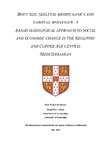Parkinson, Eóin
The central Mediterranean during the 4th-3rd millennia BC is traditionally considered a period of economic and social transformation between the Neolithic and Bronze Age, characterised by agricultural intensification, technological innovation, and the emergence of gendered society. This project directly investigates these social and economic processes through a bioarchaeological approach which investigates body size, as reflective of physiological and nutritional stress, and long bone skeletal biomechanics, as reflective of habitual behaviour. This research uses metric data derived from 3D models of humeri, femora and tibiae in 17 human skeletal assemblages from across the central Mediterranean and features comparative analysis with a large sample of individuals spanning the Upper Palaeolithic to Modern periods. The application of 3D scanning also enabled the use of novel methods in the analysis of fragmented skeletal remains. The analysis of body size documents a pronounced reduction in body mass and stature during the Neolithic, followed by a gradual recovery in the Copper and Bronze Ages. The results suggest that the transition to agriculture was initially challenging for early farming groups in the central Mediterranean, resulting in increased physiological and nutritional stress. The biomechanical analysis of the humerus found that the intensification of agriculture in the Copper Age was characterised by a wider range of manual behaviours, reflecting the introduction of diverse economic tasks and craft specialisation. The analysis of the humerus also found no evidence for sexual division of labour in the Copper Age, contrasting with the widely accepted models of social change that have been proposed for the period. The analysis of the lower limb observed a decline in robusticity following the Neolithic, indicating that Copper Age groups were less terrestrially mobile than Neolithic groups. The results of this thesis demonstrate the effectiveness of a bioarchaeological approach in exploring social and economic change in prehistory and provide a framework for future research on the Copper Age of the central Mediterranean.Keywords
Bioarchaeology, Skeletal biomechanics, Mediterranean Prehistory, Italian Prehistory, Maltese Prehistory, Human Osteology, Copper Age, Neolithic, Sardinian Archaeology, Italian Archaeology, Maltese Archaeology, commingled bone, collective burialSponsorship
Arts & Humanities Research Council Studentship, University of Cambridge Doctoral Training Partnership Robert Gardiner Memorial Scholarship (Honorary Award)Identifiers
This record's DOI: https://doi.org/10.17863/CAM.48812Rights
All rights reserved, All Rights ReservedLicence URL: https://www.rioxx.net/licenses/all-rights-reserved/Advisors
Stoddart, SimonStock, JayDate
2020-04-25Awarding Institution
University of CambridgeAuthor Affiliation
ArchaeologyQualification
Doctor of Philosophy (PhD)Language
EnglishType
Thesis










 Stumble It!
Stumble It!

No comments:
Post a Comment